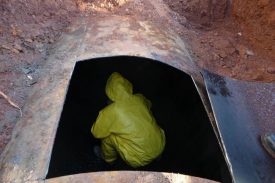Removing Your Underground Storage Tank – 5 Things You Need to Know
 When researching underground storage tank (UST) removal, it’s easy to find a variety of horror stories. Thankfully, though, we’re here to ease your woes. It’s time to put aside anxiety and get the facts.
When researching underground storage tank (UST) removal, it’s easy to find a variety of horror stories. Thankfully, though, we’re here to ease your woes. It’s time to put aside anxiety and get the facts.
Here are five important things to know when planning an underground oil tank removal:
- Know that documentation is required each step of the way. Homeowners can’t do this process by themselves. A construction permit is needed for the initial excavation. Construction demolition, fire and/or plumbing permits are required and must be issued by the municipality’s construction office. Ultimately, the removal will be inspected and approved by town construction officials.
- Know what the excavation involves. Once construction permits are obtained, the tank is excavated and cut open. Then, the surplus fuel and sludge is pumped out, and the tank is manually cleaned. If no leak is found, the entire tank is taken away to a steel recycling facility. Often times, when a UST is in excellent condition, the only action necessary is getting a local construction inspection and backfilling the excavation with clean soil. However, if corrosion holes are observed, the soil—in most cases—will be tested.
- Know the warning signs of a leaking tank. More often than not, there are no indications of trouble with your underground tank, as most leaks are not large enough to notice an increase in oil consumption. However, if you are having trouble with your tank and have noticed that you often need to call for service, you may have a leaking oil tank. Other indicators of a leaking tank are water or excessive sludge in the tank.
- Know what happens if your tank is, in fact, leaking. The New Jersey Department of Environmental Protection (NJDEP) is notified and a case number is assigned to your property. Your homeowners insurance should be notified of a possible claim. In many cases, homeowners’ insurance will have coverage for third-party liability claims. The soil directly under the tank is checked to make a preliminary determination about the extent of contamination and whether groundwater is contaminated. The open excavation will then be lined with plastic, and filled to grade until a remediation work plan is determined.
- Know the competency of the professionals you hire. Choose your company carefully! NORCON takes care of all permits and knows how to detect corrosion. If you have coverage, NORCON will work with your insurance company to design and execute a plan to remove the contamination from your property, and file the reports necessary to obtain a No Further Action Letter from the NJDEP.
For over a decade, the NORCON team has been safely removing underground storage tanks (USTs) from NJ properties. Our trained, experience staff works with clients to ensure that the process goes quickly and smoothly—and without damaging your property. NORCON also provides clients with a UST removal report along with photographs, receipts and copies of all permits obtained for the project. With NORCON, you are never alone in this process—no matter what kind of underground storage tank you have.
Have additional questions? Call us at (201) 230-8800 and ask us about a free site inspection.


